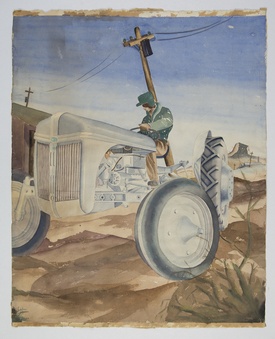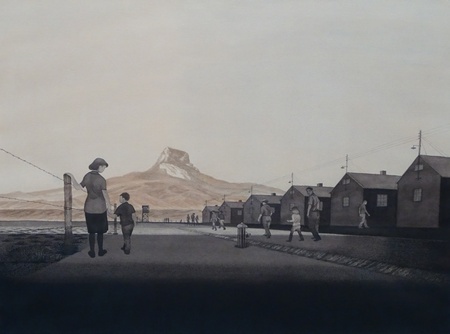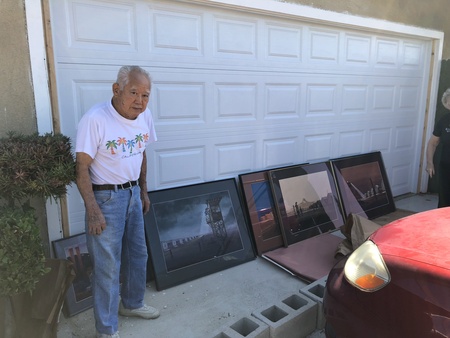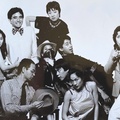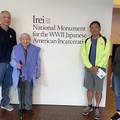It’s no secret that Heart Mountain was the inspiration for many artists held in captivity at the incarceration center that bore its name. The lonely peak towering over the vast wasteland of Wyoming’s Bighorn Basin became a symbol of isolation, perseverance, and hope for many who lost their freedom while under its spell—a symbol that most likely roused a number of artists like Estelle Peck Ishigo, the celebrated Caucasian sketch artist and watercolorist known for having been voluntarily imprisoned with her Nisei husband. Ishigo used the peak for the title of her book, Lone Heart Mountain, while other artists, like Benji Okubo and Hideo Date, founded a notable art school there.
One young art practitioner, who claims he does not remember having met Estelle Ishigo while imprisoned at Heart Mountain, was Joe Nakanishi. In 1942, Nakanishi had just graduated from high school when he and his family were shipped off to the Wyoming detention center. The 19-year-old fledgling artist had been contemplating going to art school when the mass evacuation destroyed his hopes.
With no formal training behind him, he managed to keep a sketchbook of drawings during camp days. Apparently spotting his talent were art appreciators like Ishigo, who evidently acquired a couple of his mini watercolor paintings. These were recently uncovered as part of the now-famous Eaton Collection, the huge compendium of camp artifacts once threatened to be sold off at auction before being saved by a group of Japanese Americans who fought for its protection.
While examining the paintings in the Eaton collection, now housed at the Japanese American National Museum, Heart Mountain Interpretive Center executive director Dakota Russell spotted a watercolor that was a mini version of a larger one that was part of a large collection recently donated to the Center by the Nakanishi family. To further confirm the identity of the artist, the name on the back of one of them read, “Nakanishi.”
The story behind Nakanishi’s camp art—that was to be featured in a stand-alone exhibition at the Heart Mountain Interpretive Center—goes far beyond the Eaton collection. Apparently, Nakanishi drew mainly pencil sketches while in camp and had hoped to turn them into watercolors at some point. That goal was forestalled as he began his long postwar journey to becoming a productive commercial artist.
After relocating in Chicago after the war, he worked briefly as an apprentice artist in an engraving shop and then got a job as a graphic designer for six years. He then moved back to LA, where he began building a career as a successful commercial illustrator. His assignments included work for such prestigious companies as Disney and CBS Studios. He finally landed a job at the Natural History Museum of Los Angeles County, where the job of designing the logo for the La Brea Tar Pits was among his assignments. After learning that the head of the Museum wanted a depiction of a cat, he came up with the design of the saber-toothed cat (also known as a saber-toothed tiger) that now graces all its signs.
In the meantime, Nakanishi had kept his camp artwork completely to himself for decades while living in Los Angeles after the war. Only after his nephew, Paul Nakanishi, discovered the art in his uncle’s garage did the beautiful work come to light.
When he finally retired in the 1990s at age 63, Nakanishi realized that his eyesight was starting to fail him. That’s when he decided to finish his long envisioned project to produce watercolors of all the sketches he had drawn while imprisoned at Heart Mountain. Approximately ten watercolor pieces currently on display at the Heart Mountain Interpretive Center are the result of this postwar work. What is amazing about them is that they capture life in camp from the first-hand artistry of a young man observing everyday camp activities as it was unfolding. As Nakanishi put it, “I showed the things that I saw, just what I saw.”
One amusing story Nakanishi tells involves the exhibition’s featured sketch of one of the guard towers. Apparently, guards and inmates were specifically told not to interact, but while Nakanishi was drawing the tower from the ground below, a guard noticed him. The drawing took Nakanishi more than an hour to complete, and the guard silently cooperated by standing prominently in his purview the entire time—as if to pose for the young artist. Nakanishi humbly added, “I think the guard enjoyed me painting that; I think he did.”
Now 96 years old and still living in Los Angeles, Joe Nakanishi is finally getting the recognition he deserves. His one-man exhibition, Perspective: Joe Nakanishi, featured at the Heart Mountain Interpretive Center, garnered him national attention. In typical Nisei fashion, Nakanishi still prefers staying out of the limelight and prefers to express gratitude for the people along the way who helped his career as well as appreciation for those who enjoy his art
Still, one can’t help wanting to learn more about the amazing young artist who used his talent to capture a time and place through art that illuminates our understanding of this dark period in American history with realistic detail and graceful artistry.
*A version of this article was originally published on The Rafu Shimpo on February 26, 2019.
© 2019 Sharon Yamato


